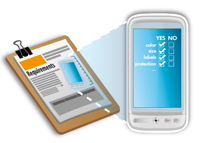 I noticed many people confuse two things: the list of potential defects, and the list of checkpoints to follow during an inspection.
I noticed many people confuse two things: the list of potential defects, and the list of checkpoints to follow during an inspection.
What I see very often is a list of potential defects, but no list of checkpoints.
There are 2 main problems with this:
- The inspector has no structure to follow.
- When random sampling is used, the inspector should NOT count every problem he finds as a defect. If he checks a point on the full sample size (for example on 200 pcs), that’s fine. But this is not valid if he only checks a few samples for a certain point. It would mean the statistics are twisted.
Here are a couple of examples to illustrate this second point:
- The export carton weight is usually checked only on a few cartons. Not on all selected cartons. If a few cartons have the wrong weight and do not conform to the buyer’s specs, no need to check all cartons. The inspection result is “on hold” or “failed”.
- Setting an electrical widget on and then off can usually be done on all inspected samples. So it makes sense to count every non-functioning widget as a defect (usually with major severity).
What is a list of potential defects?
- It is a reminder for the inspector when it comes to the visual check.
- It sets the quality standard and reduces the probability of a heated conversation between the factory and the inspector. A good defect list shows the severity (critical/major/minor) of each type of defect. And the best defect lists also illustrate (with photos if possible) what the limit is between a defect and a non-defect.
- It cannot be exhaustive. There might always be new types of defects.
- The inspector sums up the defects he/she has found. For random inspections, he/she compares them to the AQL limits.
- It usually looks like this:
What is the problem if you only prepare a defect list? You leave a lot of room to the inspector to decide how he is going to organize his inspection and how it will be performed in the details. And you are fooling yourself if you imagine he’s going to check the weight of every carton (for example)!
What are the 3 most common categories of defects?
American national standard ASQ/ANSI ID1:2021 suggests these 3 categories:
- Critical – may lead directly to severe injury or catastrophic economic loss.
- Major – may cause major problems during normal use. A major defect will likely result in reduced usability of the product. It may also lead to injury or significant economic loss.
- Minor – may cause minor problems during normal use such as noise or vibration.
What is a list of checkpoints?
- It guides the inspector step by step. It is a kind of to-do list.
- The inspector has to tick each point, as he goes through the inspection. There is no way to forget one point, and no excuse should problems be found later.
- It carries more information than a defect list. It specifies what to do, with what settings, what exact result is expected, what equipment to use, etc.
- A point can be checked on the whole sample size (especially if it takes little time and it is very important) or on a smaller sample.
- In case a point is checked on the whole sample size, a problem can be counted as a defect. There is overlap here between the two documents.
- In case a point is NOT checked on the whole sample size, a problem is simply counted as critical. That checkpoint is failed or on hold, and the whole inspection report is failed or on hold for that reason.
- It usually looks like this:
Or it can be a very simple checklist, used over a number of different products, that looks like this:
*****
Some inspection companies try to apply the AQL tables to everything they can, including to the size check of garments. It is possible but I am not a fan of that approach, as I wrote here.
What is the problem if you only prepare a list of checkpoints? You leave a lot of room to the inspector to decide on the severity of the defects he finds.
*****
I hope I made the difference clear. Any questions or remarks?
Sofeast: Quality Assurance In China Or Vietnam For Beginners [eBook]
This free eBook shows importers who are new to outsourcing production to China or Vietnam the five key foundations of a proven Quality Assurance strategy, and also shows you some common traps that importers fall into and how to avoid or overcome them in order to get the best possible production results.
Ready to get your copy? Hit the button below:




